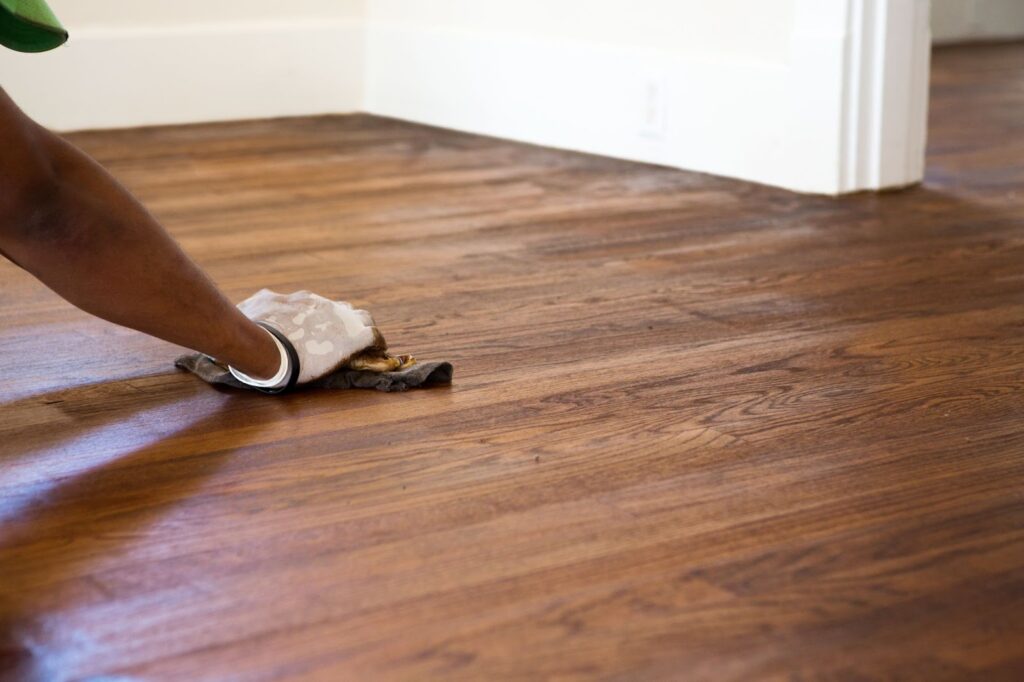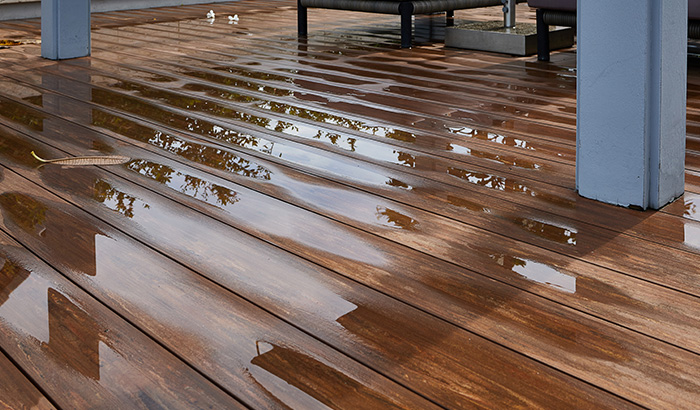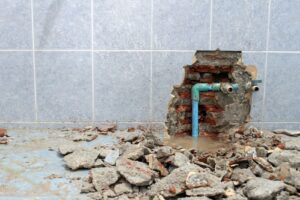Hardwood floors have long been the epitome of sophistication and charm in homes across the world — that is until water damage mars them.
The hues and intricate grains of hardwood floors breathe life into rooms, creating a cozy and inviting ambiance. This makes hardwood floor water damage all the more devastating. Water damage goes beyond the surface of water stains. It strikes at the heart of the wood, compromising its strength and durability.
Whether it’s the aftermath of an unexpected flood, a sneaky leak, or the subtle effects of humidity over time, water damage on wood floors can be a homeowner’s worst nightmare.
In this comprehensive guide, we’ll delve deep into understanding the true impact of water on these beautiful floors, offering insights into prevention and, if needed, restoration. If you cherish your hardwood floors as much as we think you do, equip yourself with the knowledge and tools to ensure your floors remain as pristine as the day they were installed.
The Impact of Water on Hardwood Floors
Hardwood floors are a favorite among homeowners with their natural charm and durability. Yet, they are not immune to the detrimental effects of water damage. Understanding the impact of water on wood floors is essential to ensure their longevity and maintain their aesthetic appeal.

1. Warping and Cupping
One of the most common signs of hardwood floor water damage is the alteration in the shape of the wood planks. When water seeps into the wood, it causes the edges to rise, creating a concave appearance known as cupping. Conversely, if the center of the plank swells more than the edges, it results in a convex shape, termed crowning. Both these conditions compromise the smoothness and uniformity of the floor.
2. Discoloration and Staining
Water damage on wood floors often manifests as discoloration or staining. Dark spots typically indicate that water has penetrated the wood’s finish, while white or cloudy stains suggest moisture trapped between the finish and the wood. These stains detract from the floor’s natural beauty and may require refinishing or replacing the affected planks.
3. Buckling
In severe cases of prolonged water exposure, hardwood floorboards might detach from the subfloor, leading to a phenomenon called buckling. This is one of the most extreme reactions to water damage, where the boards lift from the ground, creating an uneven and potentially hazardous surface.
4. Wood Rot and Mold Growth
Persistent moisture leads to wood rot, where the wood starts to decay and lose its structural integrity. Additionally, damp environments are conducive to mold growth, further deteriorating the wood and posing health risks.
5. Cracking and Splitting
Repeated cycles of water absorption and drying causes the wood to crack or split. These cracks are unsightly and dangerous as they might lead to splinters or further water intrusion.
6. Odors
Musty odors are often a telltale sign of water damage. These smells arise from mold or mildew growth and indicate underlying moisture issues.
7. Finish Damage
Water adversely affects the protective finish on hardwood floors, causing it to peel, become cloudy, or develop white spots. A damaged finish diminishes the floor’s appearance and reduces its resistance to further water damage.
8. Structural Damage
If water seeps through the hardwood and reaches the subfloor, it can lead to structural damage. This not only affects the floor but also compromises the overall integrity of the home.
While hardwood floors are undeniably beautiful and durable, they are susceptible to the adverse effects of water damage. Recognizing the signs and understanding the implications is the first step in addressing and preventing further damage, ensuring that your floors remain as stunning as the day they were installed.
Preventive Measures and Maintenance
Hardwood floors are a testament to elegance and longevity, but they require vigilant care to fend off potential threats, especially water damage. Protecting these floors from the adverse effects of moisture takes more than reactive measures; it’s about being proactive. By adopting preventive strategies and regular maintenance, you ensure that your floors remain pristine and free from the perils of hardwood floor water damage.
1. Immediate Action
The first line of defense against water damage on wood floors is a swift response. Whether it’s a minor spill or a significant leak, addressing the issue immediately prevents the water from seeping deeper into the wood. Wipe up spills as soon as they occur, and promptly address any leaks or moisture sources. This immediate action can differentiate between a quick cleanup and extensive repairs.
2. Regular Maintenance
Consistent care is the key to preserving the beauty and integrity of hardwood floors. Regularly cleaning the floors with products designed for hardwood prevents the buildup of moisture and potential water damage. Additionally, consider refinishing your floors periodically. A fresh coat of finish not only revitalizes the floor’s appearance but also adds an extra layer of protection against moisture.
3. Proper Installation:
Ensuring that hardwood floors are correctly installed prevents water damage. Proper installation means ensuring no gaps or spaces where water can seep in. It also involves choosing the right type of wood and finish for the specific environment and conditions of your home.
4. Use of Rugs and Mats
Strategically placing rugs and mats in high-traffic areas or spots prone to spills is a simple yet effective preventive measure. Not only do they add to the decor, but they also act as a barrier, absorbing spills and preventing direct contact of water with the wood.
Adopting a proactive approach, coupled with regular maintenance, goes a long way in safeguarding your floors from the detrimental effects of moisture. Remember, the longevity and beauty of your hardwood floors are as much about prevention as they are about care and maintenance.
Restoration and Repair
Experiencing hardwood floor water damage is distressing. It’s essential to remember that, in many cases, these floors are restorable to their former glory. While prevention is always the best approach, sometimes water damage is unavoidable. When faced with such situations, understanding the restoration and repair process is helpful.
Let’s delve into the steps involved in bringing your hardwood floors back to life.
1. Drying Techniques
The immediate aftermath of water damage on wood floors requires swift and effective drying. Using fans, dehumidifiers, and other drying equipment expedites the removal of moisture from the wood. It’s crucial to thoroughly dry the floor to prevent mold growth and further damage.
2. Refinishing vs. Replacing:
Once the floor is dry, the next step is to assess the extent of the damage. Minor damages might only require refinishing, which involves sanding the surface and applying a fresh coat of finish.
However, in cases of severe damage, where the wood is warped, buckled, or rotted, replacement of the affected planks may be necessary. Accurately assessing your floor will ensure the longevity and aesthetics of the floor.

Professional Consultation
Hardwood floor water damage can be complex, and while some homeowners might be tempted to tackle the restoration themselves, seeking professional help is often the best course of action. Professionals bring expertise, experience, and specialized equipment to the table, restoring the floor correctly and efficiently.
Mold Remediation
One of the terrible aftermaths of water damage is mold growth. If you suspect any mold growth, it’s imperative to address it immediately. Mold not only damages the wood but also poses significant health risks. Professional mold remediation services effectively remove mold and prevent its recurrence.
Water damage is a formidable adversary to hardwood floors; however, it’s not the end of the road. With the right approach, tools, and expertise, hardwood floors can be restored and repaired, reclaiming their beauty and function. Whether you’re refinishing, replacing, or seeking professional consultation, the key is to act promptly and make informed decisions to combat the effects of water damage.
Restoring Your Wood Floors With Utah Disaster Clean Up & Restoration
Navigating the aftermath of hardwood floor water damage is an overwhelming task. From assessing the damage to choosing the proper restoration techniques, every step is crucial in ensuring the longevity and beauty of your floors.
You don’t have to face this challenge alone. Utah Disaster Clean Up stands as a beacon of support, offering expert water damage restoration services tailored to address the unique needs of hardwood floors. Our team of professionals has the knowledge, experience, and tools to restore your floors to their former glory, ensuring a seamless and efficient restoration process.
If you find yourself grappling with the effects of water damage, don’t hesitate. Reach out to the experts at Utah Disaster Clean Up. Whether you have questions, need an assessment, or are ready for restoration services, we are here to help.
For personalized assistance, contact Utah Disaster Clean Up & Restoration directly or call us at (435) 512-1584. Your hardwood floors are an investment in your home’s beauty and value; with the right help, they will shine again. Don’t let water damage dim their luster; take action today, and experience the assurance of expert intervention.



